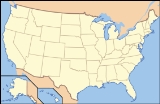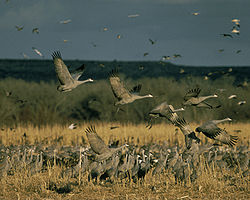
Lake Andes National Wildlife Refuge
Encyclopedia
Lake Andes National Wildlife Refuge is located in the U.S. state
of South Dakota
and includes 5,638 acres (22.81 km2). The refuge is managed by the U.S. Fish and Wildlife Service and is part of the Lake Andes National Wildlife Refuge Complex
. Only 938 acres (3.79 km2) is under U.S. Government ownership with the rest being an easement to ensure greater habitat protection.
Lake Andes is a natural lake that is fed by underground springs and about every 20 years, the lake dries up. Two dikes separate the lake into three sections, allowing better water retention during the dry summers. Over one hundred species of birds nest here including Bald eagle
s, Ring-necked pheasant, Northern pintail
and numerous species of ducks and geese.
 Various mammal
Various mammal
species inhabit the refuge, including White-tailed deer
, coyote
, and badger
, muskrat
which are all relatively common.
U.S. state
A U.S. state is any one of the 50 federated states of the United States of America that share sovereignty with the federal government. Because of this shared sovereignty, an American is a citizen both of the federal entity and of his or her state of domicile. Four states use the official title of...
of South Dakota
South Dakota
South Dakota is a state located in the Midwestern region of the United States. It is named after the Lakota and Dakota Sioux American Indian tribes. Once a part of Dakota Territory, South Dakota became a state on November 2, 1889. The state has an area of and an estimated population of just over...
and includes 5,638 acres (22.81 km2). The refuge is managed by the U.S. Fish and Wildlife Service and is part of the Lake Andes National Wildlife Refuge Complex
Lake Andes National Wildlife Refuge Complex
Lake Andes National Wildlife Refuge Complex consists of the Lake Andes National Wildlife Refuge, the Lake Andes Wetland Management District and the Karl E. Mundt National Wildlife Refuge. Altogether, 89,454 acres of U.S. Government and easement lands are managed by the complex. The complex is...
. Only 938 acres (3.79 km2) is under U.S. Government ownership with the rest being an easement to ensure greater habitat protection.
Lake Andes is a natural lake that is fed by underground springs and about every 20 years, the lake dries up. Two dikes separate the lake into three sections, allowing better water retention during the dry summers. Over one hundred species of birds nest here including Bald eagle
Bald Eagle
The Bald Eagle is a bird of prey found in North America. It is the national bird and symbol of the United States of America. This sea eagle has two known sub-species and forms a species pair with the White-tailed Eagle...
s, Ring-necked pheasant, Northern pintail
Northern Pintail
The Pintail or Northern Pintail is a widely occurring duck which breeds in the northern areas of Europe, Asia and North America. It is strongly migratory and winters south of its breeding range to the equator...
and numerous species of ducks and geese.

Mammal
Mammals are members of a class of air-breathing vertebrate animals characterised by the possession of endothermy, hair, three middle ear bones, and mammary glands functional in mothers with young...
species inhabit the refuge, including White-tailed deer
White-tailed Deer
The white-tailed deer , also known as the Virginia deer or simply as the whitetail, is a medium-sized deer native to the United States , Canada, Mexico, Central America, and South America as far south as Peru...
, coyote
Coyote
The coyote , also known as the American jackal or the prairie wolf, is a species of canine found throughout North and Central America, ranging from Panama in the south, north through Mexico, the United States and Canada...
, and badger
Badger
Badgers are short-legged omnivores in the weasel family, Mustelidae. There are nine species of badger, in three subfamilies : Melinae , Mellivorinae , and Taxideinae...
, muskrat
Muskrat
The muskrat , the only species in genus Ondatra, is a medium-sized semi-aquatic rodent native to North America, and introduced in parts of Europe, Asia, and South America. The muskrat is found in wetlands and is a very successful animal over a wide range of climates and habitats...
which are all relatively common.

